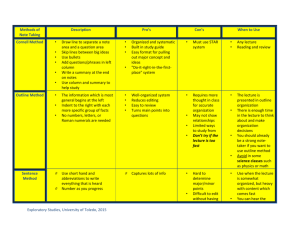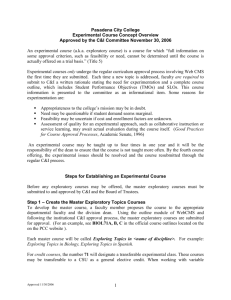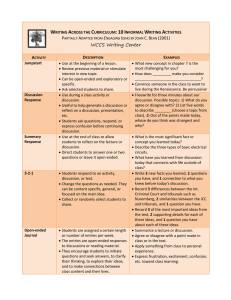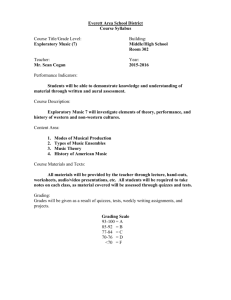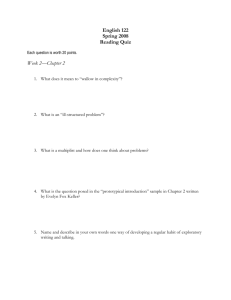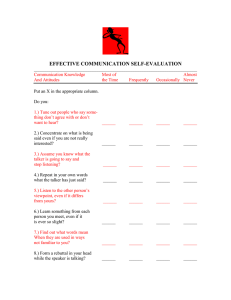SRS Developing our students learning skills
advertisement
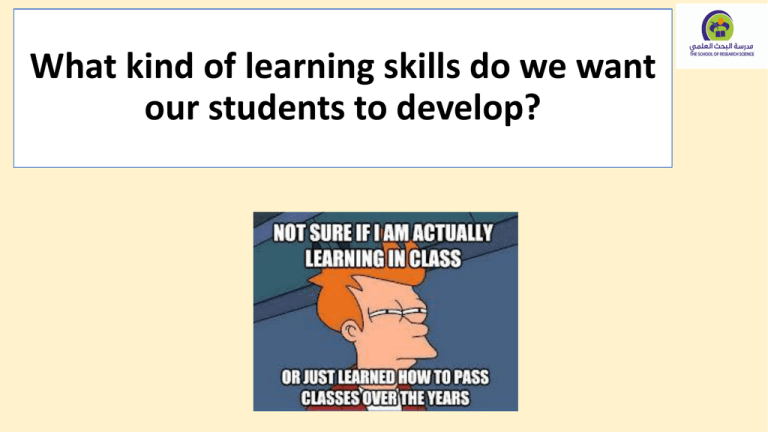
What kind of learning skills do we want our students to develop? What kind of learning skills do we want our students to develop? • Students who take responsibility for their own learning? • Students who can reflect on their own learning? Aware of own strengths and weaknesses • Students who can collaborate in a wide range of learning situations • Students who are Independent learners • Students who can contribute their own ideas, ask questions and listen to each other • Students who can think and problem solve What some teachers do • Clear learning intentions • Challenging success criteria • Range of learning strategies • Know when students are not progressing • Provide feedback and give opportunities for reflection • Visibly learn themselves Such that students…… • Understand learning intentions • Are challenged by success criteria • Develop a range of learning strategies • Know when they are not progressing • Seek feedback for themselves • Visibly teach themselves Developing our students as learners Rachael Edgar Monday 12th January 2013 Benefits? • Safe, free, teachers can give feedback and post grades and parents can view child’s work and grades. • On the staff page, library for resources and notifications when students comment or produce work. • Good for communication with parents • Summative/formative feedback- set assignments and link to resources and comment on submitted work. Rehearsing knowledge and understanding Practice is essential for consolidating learning and understanding Collaborative learning Collaboration can help deep learning Engagement Uncertain rewards enhance engagement and promote learning Learning processes Stimulation of the brain's reward system supports learning Competition Brains respond to our own successes and to the failures of our competitors Classroom practice The importance of pedagogy in game-based teaching and learning Benefits? Flip the classroom- Find, add, share online content, vids, images, PDFs, Google Docs. Students can comment/take notes alongside content. Track student progress All you digital content in one place! Personalise student learning with different online materials and built in assessment Blendspace- How to get started? http://www.youtube.com/watch?v=aQ_Mg3lSoew Blendspace- Student tracking http://www.youtube.com/watch?annotation_id=annotation_1963439531&f eature=iv&src_vid=aQ_Mg3lSoew&v=I1zID7fcqcM Really? “Teachers are USELESS at ________________” Professor Neil Mercer 2010 Effective collaboration “What the child learns to do in cooperation with others, he will learn to do alone.” Lev Vygotsky, Mind and Society, 1978 “Talk is the sea upon which all else floats” James Britton, Language and Learning, 1970 1. Many students may not know how to talk and think together effectively 2. Their teachers assume they do •Encouraging/ modelling the use of exploratory/high quality talk •Strategies for getting them talking Teacher: What is the chemical symbol for Oxygen? Teacher: With your partner, discuss what you know about Oxygen. (suitable pause) Sara, what do you know about Oxygen? Sara: O is the chemical symbol for Oxygen. Student: O Teacher: Alia is she right? Alia: Er… yes? Teacher: Well done. Teacher: What else do you know about Oxygen? Alia: You breathe it. Teacher: Mariam , which of those answers do you think is the most interesting? …in which partners engage critically but constructively with each other's ideas; everyone participates; tentative ideas are treated with respect; ideas may be challenged; challenges are justified, reasons are given and alternative ideas or understandings are offered; opinions are considered before decisions are made and agreement is sought. Knowledge is made publicly accountable and so reasoning is visible in the talk. Exploratory Talk: When group work goes right • • • • • • • Talk is really important for learning!!!! Sharing your ideas with somebody else is learning Everyone offers relevant information Everyone's ideas are treated as worthwhile People ask each other what they think People ask for reasons and give them People try to reach agreement People don’t just interact - they interthink! Exploratory Talk- How to do it! What do you think? Is there another way of looking at this? I agree with you because… What have we agreed? The opposite view would be... What are your reasons? Have we considered all of the factors? I disagree with you because… What if? Another reason is… Group Activity One- Icebreaker • In pairs: 1. Think of a famous person and write their name down on a post it, don’t tell your partner who it is 2. Stick the post it note to your partners forehead 3. The task is for the person with the post it on their head to try and guess who it is, the other person can only answer yes or no 4. You have 2 minutes Group Activity Two- Debate • In groups of 3: 1. Take a card from the brown envelope, in your group you have 2 minutes to debate the issue on the card 2. Remember the rules for great group work and talk: • Everyone offers relevant information • Everyone's ideas are treated as worthwhile– but are critically evaluated • People ask each other what they think • People ask for reasons and give them • People try to reach agreement • Use the prompt phrases on your table to help you! Group Activity Three- Design a Mammal • In groups of 3: • You have to design a mammal to live in the Canadian Arctic • (very low temperatures and constant darkness in the winter, and temperatures above freezing and constant daylight in the summer) • Choose SIX characteristics from the cards in the white envelope and these must make a sensible animal • Use the exploratory talk prompts on your table to help structure your groups conversation about which characteristics to choose • Using the A3 paper draw your animal and give him/her a name • You have 10 minutes! Circle Time Philosophy for Children Rainbow Groups Snowballing Pair Talk Listening Triad Envoys Jigsawing Value Continuum Hot Seating Distancing Goldfish Bowl Freeze Frame Six Thinking Hats Free Discussion Radio Phone-In TV Chat Show Circle of Voices Post-It Dialogues Rotating Stations Think-Pair-Share 3-Step Interview Purpose: To express opinions, show values, discuss differences of opinion, engage in public discussion. Set Up: Use a piece of rope or string for the continuum; have arrows pointing on the board; place the two extremes of opinion on opposite walls. How it works: In this format students or groups of students have to respond to a thought provoking statement by saying to what degree they agree with it. There are a number of ways this can to used: the students could be asked to come and stand at the point on a line that represents their individual opinion, alternatively, first they could be asked to discuss a statement in groups and then for one of the group to come up to the front and place their groups card/token somewhere along the line, explaining the position their group have taken as they do so. This is an excellent format for comparing responses to different questions and finding out contradictions in their thinking Purpose: Encourages every student to listen (to their home group) and talk (to their colour group) Set Up: Standard group work set up with space to move and discuss. How it works: Place students in groups with a topic (the same for all, or different topics) to discuss (this is their ‘home’ group). After discussion students are given a colour and regroup accordingly. The new groups should have a member from each of the ‘home’ groups. The students then take it in turns to report back what their groups discussed. This can then lead into further discussion. Purpose: Structured means of eliciting information, developing concepts and understanding and processing what is said. Also promotes self-awareness through role of observer. Set Up: Students in threes, two sat facing, one slightly offset – not engaged but observing. How it works: Pupils work in groups of three. Each pupil takes on the role of talker, questioner, recorder. The talker explains something, or comments on an issue, or expresses an opinion. The questioner prompts and seeks clarification The recorder makes notes and gives a report at the end of the conversation. Next time, roles are changed. Using the Talk Toolkit plan an activity you can do to get your students talking Further reading: Mike Gershon 40 strategies for encouraging discussion Daniel Willingham

